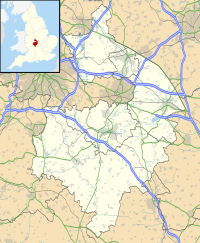All Saints Church, Chadshunt
| All Saints Church, Chadshunt | |
|---|---|

All Saints Church, Chadshunt, from the southeast
|
|
| Coordinates: 52°10′28″N 1°29′26″W / 52.1744°N 1.4906°W | |
| OS grid reference | SP 349 530 |
| Location | Chadshunt, Warwickshire |
| Country | England |
| Denomination | Anglican |
| Website | Churches Conservation Trust |
| History | |
| Dedication | All Saints |
| Architecture | |
| Functional status | redundant |
| Heritage designation | Grade II* |
| Designated | 30 May 1967 |
| Architectural type | Church |
| Style | Norman, Gothic |
| Groundbreaking | Mid-12th century |
| Completed | c. 1730 |
| Specifications | |
| Other dimensions | Nave 51 feet (15.5 m) by 18 feet (5.5 m) Chancel 13.5 feet (4.1 m) by 17 feet (5.2 m) Transept 15 feet (4.6 m) by 14 feet (4.3 m) |
| Materials | Ironstone, tile roofs |
All Saints Church is a redundant Anglican church in the parish of Chadshunt, Warwickshire, England. It is recorded in the National Heritage List for England as a designated Grade II* listed building, and is under the care of the Churches Conservation Trust. It stands by the side of the road from Kineton to Southam. Its general appearance is "long, low and massive".
The earliest fabric in the church is in the eastern part of the nave which dates from the middle of the 12th century. The nave was lengthened towards the west in the 14th century. Early the following century a clerestory was added to the nave, the south wall was refaced, and buttresses were added. In the 17th century the west tower was built and in about 1730 the chancel and north transept were added. The roof was repaired in 1866, and a restoration was carried out in 1906. The church vested in the Churches Conservation Trust on 1 May 1988.
The church is constructed in ironstone, with tiled roofs. Its plan consists of a three-bay nave with a clerestory, a single-bay chancel, a north transept, and a west tower. The approximate dimensions are: the nave 51 feet (15.5 m) by 18 feet (5.5 m), the chancel 13.5 feet (4.1 m) by 17 feet (5.2 m), and the transept 15 feet (4.6 m) by 14 feet (4.3 m). The roof of the chancel is higher than that of the nave. In the nave there are doors in the north and south walls of Norman origin. The north door has a round-headed arch, but the south door was altered in the 14th century, giving it a pointed arch. To the right of the south doorway is a buttress and a window of paired lancets, and to its left is a 14th-century two-light window. The clerestory has three straight-headed windows on each side; these are also paired lancets. On the east and west sides of the transept is a round-headed window, and in the north wall is a two-light window. In the east wall of the chancel is a Venetian window, and the south wall contains a round-headed window. The tower is in two stages with diagonal buttresses. On the west side of the lower stage is a door, above which is a two-light window. The upper stage contains a two-light louvred bell opening on each face. At the top of the tower is a moulded cornice and a crenellated parapet.
...
Wikipedia

